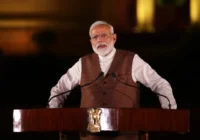Fears resurface of Pakistan stoking Sikh separatism in the Indian state of Punjab.
In November 2018, an attack against the premises of the Sant Nirankari Mission in the Indian state of Punjab has once again brought back fears of the revival of Pakistan-backed Sikh separatism, known as the Khalistan movement. Nirankari is seen as heretic by orthodox and extremist Sikhs and has historically found itself at the receiving end of violence for worshiping a living guru against the conventional Sikh belief of absolute loyalty to the holy book, the Guru Granth Sahib. On April 13, 1978, a bloody clash between Nirankaris and extremist Sikhs left 13 dead. Two years later, in 1980, Nirankari’s spiritual leader, Baba Gurbachan Singh, was killed in Amritsar.
These incidents marked watershed moments that brought the Sikh extremist leader, Jarnail Singh Bhindranwale, into prominence, propelling Punjab into a dark and bloody decade of militancy. Supported by Pakistan’s foreign intelligence agency, the Inter-Services Intelligence (ISI), the Khalistan movement was a major challenge to India’s unity in 1970s and 1980s. India lost an estimated 11,694 lives between 1981 and 2000 as a result of the violence in Punjab, despite that fact that the movement’s most active phase ended in 1993, after suppression by Indian security forces.
Since then, Punjab has seen relatively peaceful and prosperous times, emerging as one of the wealthiest states in India, with robust agriculture, industry and a massive inflow of foreign remittances. However, the fears of the revival of Khalistan militancy never completely receded. The Sikh separatist sentiment, though driven from the mainland, was still flourishing among the Sikh diaspora in the US, UK, Europe and Canada due to permissive political climates.
On September 13, 2013, Sikh extremists in central London attempted to murder retired Lt. General Kuldeep Singh Brar, the man who commanded Operation Blue Star — a military operation launched in 1984 by the Indian Army to flush out Sikh militants from a sacred Sikh shrine, the Golden Temple of Amritsar — stabbing him in the neck. In mainland Punjab, Sikh organizations like Dal Khalsa and Damdami Taksal have kept the Khalistan issue alive with covert patronage by some political parties.
Diaspora
The second generation of the Sikh diaspora often lacks real-time exposure to India’s interreligious harmony and diversity. Nurtured on the anti-India propaganda engineered by Sikh extremist leaders and the ISI, the youth in the diaspora is sympathetic to the Khalistan movement. Organizations like Babbar Khalsa International (BKI), Khalistan Commando Force (KCF) and International Sikh Youth Federation (ISYF) — banned in a number of countries including India, the US, Canada and the European Union — play an important role in this narrative. The 2018 US counterterrorism strategy categorically stated that BKI wants to establish an independent Sikh state through terror and violence.
After Sikh militancy was crushed in Punjab, these groups largely confined themselves to low-profile activism. However, from 2015 the Khalistan movement has been on the rise again. Informed sources indicate that Sikh extremist groups have moved beyond activism and have started indulging in violent activities. The Sikh diaspora is collecting religious donations in Punjab to revive the Khalistan movement. India Today informs that 12 militants were killed in 2015, 18 in 2016 and 17 in 2017. Four weapons were seized in 2015, 12 in 2016 and 25 in 2017, with 1,002 ammunition rounds seized in 2015, 622 in 2016 and 663 in 2017.
In several incidents of terrorist violence since 2015, Hindu nationalist leaders have been assassinated. According to India Today, six terror modules have been uncovered, and 23 suspected Khalistan terrorists arrested in Punjab since April 2017. Interrogations revealed the links between the cadres apprehended in Punjab and the Sikh extremist leaders like Lakhbir Singh Rode (who heads the ISYF), his contacts based in Western Europe and Khalistan Liberation Force’s Harmeet Singh “Ph.D.,” allegedly sheltered in ISI safe house near a Lahore military cantonment in Pakistan.
Several psy-ops have been conducted in order to revive terror in Punjab. Since 2015, more than 150 incidents of the sacrilege of the Guru Granth Sahib have been reported. It appears that the underlying objective could be to stir up Sikh sentiment against India by rejuvenating the perceptions of injustices and atrocities committed by the government in Delhi against the Sikh community. Social media is flooded with extremist audio and video content reviving memories of the Operation Blue Star anti-Sikh riots of 1982, which led to the killing of 8,000 Sikhs. Indian agencies have detected 140 Facebook Messenger groups, 125 Facebook pages and hundreds of WhatsApp groups being used to radicalize Sikh youth in Punjab. Indian intelligence agencies inform that the rise of Hindu nationalist groups and their activities in Punjab are also being used to create the perception of fear among the Sikh community. There already is a backlash against the increasingly vocal presence of radical Hindutva groups in Punjab specifically, and India in general.
The international arm of Sikh separatism is visible more in the form of civil rights activism and sophisticated propaganda operations. Sikhs for Justice (SFJ), a human rights advocacy group, has called for Referendum 2020 — a campaign to “liberate” Punjab from India and make it a nation-state. Besides, on various occasions, Indian diplomats and consular officials have been banned from entering gurudwaras — Sikh places of worship — in Canada and the US.
The Devil’s Advocate
Pakistan, India’s archenemy, is playing a lynchpin role in the revival of the Sikh militancy in Punjab. Pakistan’s support is in line with its long-term strategy of keeping India on the boil by fomenting terror in Kashmir and Punjab, provoking social unrest and creating economic turmoil. Pakistan has used terrorism as a strategic asset against India for over four decades now.
According to sources in Indian intelligence, ISI officers are acting as handlers and organizers of Sikh separatist activities in Canada, Europe, US, UK and Malaysia. Allegedly, the ISI is making vigorous attempts to revitalize the Khalistan movement by providing weapons, financial support, moral backing and propaganda in mainland Punjab and abroad. As per Indian intelligence, Lt. Colonel Shahid Mehmood Malhi, better known as “Chaudhary Sahib” among the Pakistani military, is the mastermind of Referendum 2020. Indian security services are said to have recovered documents about Referendum 2020 from his computer.
Sources inform that he headed the Lahore detachment of ISI and might have played a key role in target killings of Hindu leaders in Punjab,the terrorist attack in Dinanagar, Gurdaspur, in July 2015, and the fidayeen suicide attack on Pathankot air base in January 2016. Further, Indian intelligence agencies are of the view that ISI is trying to link up Punjab militants with terrorist organizations operating in Indian-administered Kashmir.
Pakistan has been smuggling drugs, weapons and counterfeit currency into Punjab through Firozpur, Pathankot, Tarantaran and Gurdaspur border districts in vast quantities. A recent study by the Indian government suggests that 860,000 young men aged 15-35 in Punjab are drug addicts, 53% of them addicted to heroin. The drugs render young minds vulnerable to extremist religious propaganda under the illusion of giving a meaning to their lives.
Activists engaged in youth deradicalization at the grassroots level told this author that ISI also targets the diverse organized crime syndicates in Punjab. Some of these groups are said to have expressed sympathies for the Khalistan movement on their Facebook pages, purportedly to acquire social legitimacy and weapons from ISI handlers based in Pakistan. Until now, not much development has happened on this front. However, if ISI can make inroads into the crime syndicates, things can be challenging for Indian counterterrorism agencies.
Good Will
It is easy to read into the deeper geopolitical motives behind some of the open activities of Pakistan to gain the goodwill of the Sikhs. For example, many ISI generals, including the former ISI chief Hamid Gul, have openly supported the Khalistan movement. Several Khalistan extremists are sheltered in Pakistan. Recently, Pakistan has been over-generous to its Sikh minority, opening the Kartarpur corridor between Indian and Pakistani Punjab, a demand which it has been refusing so far. Prior to this, Pakistan also released stamps in the memory of Sikhs killed by militants in Indian-administered Kashmir and exempted Sikhs from the compulsion of wearing helmets while driving, showing respect to their religious sentiments. Apart from this, it appears that Pakistan is also facilitating the support of friendly countries like Turkey for SFJ.
In mainland Punjab, the Khalistan movement isn’t high on the state’s agenda. However, the situation can become serious if not tackled properly. The authorities in Punjab think that, unlike in the last decade, there is no dearth of foot soldiers to join the movement. With the Indian elections approaching, the issue of Sikh identity and grievances will be politically sensitive. India’s government appears to be aware of the potential threat, with the central government alerting the states of a potential revival of Sikh militancy. Besides, India is also sympathetic to Sikh religious demands and grievances. It was evident recently when it relaxed its policy of no dialogue with Pakistan without the latter’s concrete action on terror by consenting to open the Kartarpur corridor.
However, India has apprehensions that the corridor might be part of a larger ISI plan to radicalize Sikh pilgrims visiting Pakistan. India’s cautious approach is visible in the fact that it has made clear that the gesture was purely out of respect for Sikh religious concerns and does not indicate a shift from its stated position. In another gesture to address Sikh grievances, the Delhi High Court upheld the conviction of 88 people for the anti-Sikh riots of 1984, a highly sensitive issue. In the future, India needs to act on multiple fronts by countering the anti-India propaganda war waged by Pakistan and Sikh extremist organizations, taking sufficient measures to keep Sikh separatism in check.
*[A version of this article was originally published by Swarajya.]
The views expressed in this article are the author’s own and do not necessarily reflect Fair Observer’s editorial policy.
Support Fair Observer
We rely on your support for our independence, diversity and quality.
For more than 10 years, Fair Observer has been free, fair and independent. No billionaire owns us, no advertisers control us. We are a reader-supported nonprofit. Unlike many other publications, we keep our content free for readers regardless of where they live or whether they can afford to pay. We have no paywalls and no ads.
In the post-truth era of fake news, echo chambers and filter bubbles, we publish a plurality of perspectives from around the world. Anyone can publish with us, but everyone goes through a rigorous editorial process. So, you get fact-checked, well-reasoned content instead of noise.
We publish 2,500+ voices from 90+ countries. We also conduct education and training programs
on subjects ranging from digital media and journalism to writing and critical thinking. This
doesn’t come cheap. Servers, editors, trainers and web developers cost
money.
Please consider supporting us on a regular basis as a recurring donor or a
sustaining member.
Will you support FO’s journalism?
We rely on your support for our independence, diversity and quality.







